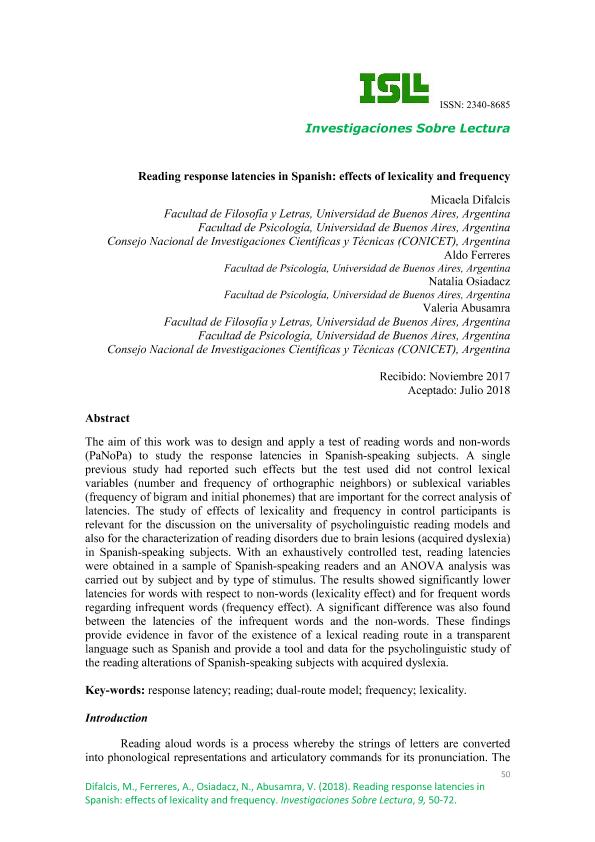Artículo
El objetivo de este trabajo fue diseñar y aplicar una prueba de palabras y no palabras (PaNoPa) para estudiar las latencias de respuesta de lectura en una muestra de sujetos hispanohablantes. Un único estudio previo había informado tales efectos pero la prueba empleada no controlaba variables lexicales (número y frecuencia de vecinos ortográficos) ni sublexicales (frecuencia de bigramas y fonemas iniciales) que son importantes para la medición correcta de las latencias. La determinación fehaciente de los efectos de lexicalidad y frecuencia en participantes controles es relevante para la discusión sobre la universalidad de los modelos psicolingüísticos de lectura y también para la caracterización de las alteraciones de la lectura por lesiones cerebrales (alexias o acquired dyslexia) en sujetos hispanohablantes. Con una prueba exhaustivamente controlada se obtuvieron las latencias de lectura en una muestra de lectores hispanohablantes y se llevó a cabo un análisis ANOVA por sujeto y por tipo de estímulo. Los resultados mostraron latencias significativamente menores para palabras respecto de no palabras (efecto de lexicalidad) y para palabras frecuentes respecto de palabras infrecuentes (efecto de frecuencia). También se encontró una diferencia significativa entre las latencias de las palabras no frecuentes y las no palabras. Estos hallazgos aportan evidencia a favor de la existencia de una ruta léxica de lectura en una lengua transparente como el español y proveen una herramienta y datos para el estudio psicolingüístico de las alteraciones de la lectura de sujetos hispanohablantes con alexia. The aim of this work was to design and apply a test of reading words and non-words (PaNoPa) to study the response latencies in Spanish-speaking subjects. A single previous study had reported such effects but the test used did not control lexical variables (number and frequency of orthographic neighbors) or sublexical variables (frequency of bigram and initial phonemes) that are important for the correct analysis of latencies. The study of effects of lexicality and frequency in control participants is relevant for the discussion on the universality of psycholinguistic reading models and also for the characterization of reading disorders due to brain lesions (acquired dyslexia) in Spanish-speaking subjects. With an exhaustively controlled test, reading latencies were obtained in a sample of Spanish-speaking readers and an ANOVA analysis was carried out by subject and by type of stimulus. The results showed significantly lower latencies for words with respect to non-words (lexicality effect) and for frequent words regarding infrequent words (frequency effect). A significant difference was also found between the latencies of the infrequent words and the non-words. These findings provide evidence in favor of the existence of a lexical reading route in a transparent language such as Spanish and provide a tool and data for the psycholinguistic study of the reading alterations of Spanish-speaking subjects with acquired dyslexia.
Latencias de respuesta de lectura en español: efectos de lexicalidad y frecuencia
Título:
Reading response latencies in Spanish: effects of lexicality and frequency
Fecha de publicación:
08/2018
Editorial:
Asociación Española de Comprensión Lectora
Revista:
Investigaciones Sobre Lectura
ISSN:
2340-8685
Idioma:
Inglés
Tipo de recurso:
Artículo publicado
Clasificación temática:
Resumen
Palabras clave:
LATENCIA DE RESPUESTA
,
LECTURA
,
MODELO DE DOBLE RUTA
,
FRECUENCIA
,
LEXICALIDAD
Archivos asociados
Licencia
Identificadores
Colecciones
Articulos(SEDE CENTRAL)
Articulos de SEDE CENTRAL
Articulos de SEDE CENTRAL
Citación
Difalcis, Micaela; Ferreres, Aldo Rodolfo; Osiadacz, Natalia; Abusamra, Valeria; Latencias de respuesta de lectura en español: efectos de lexicalidad y frecuencia; Asociación Española de Comprensión Lectora; Investigaciones Sobre Lectura; 9; 8-2018; 50-72
Compartir




